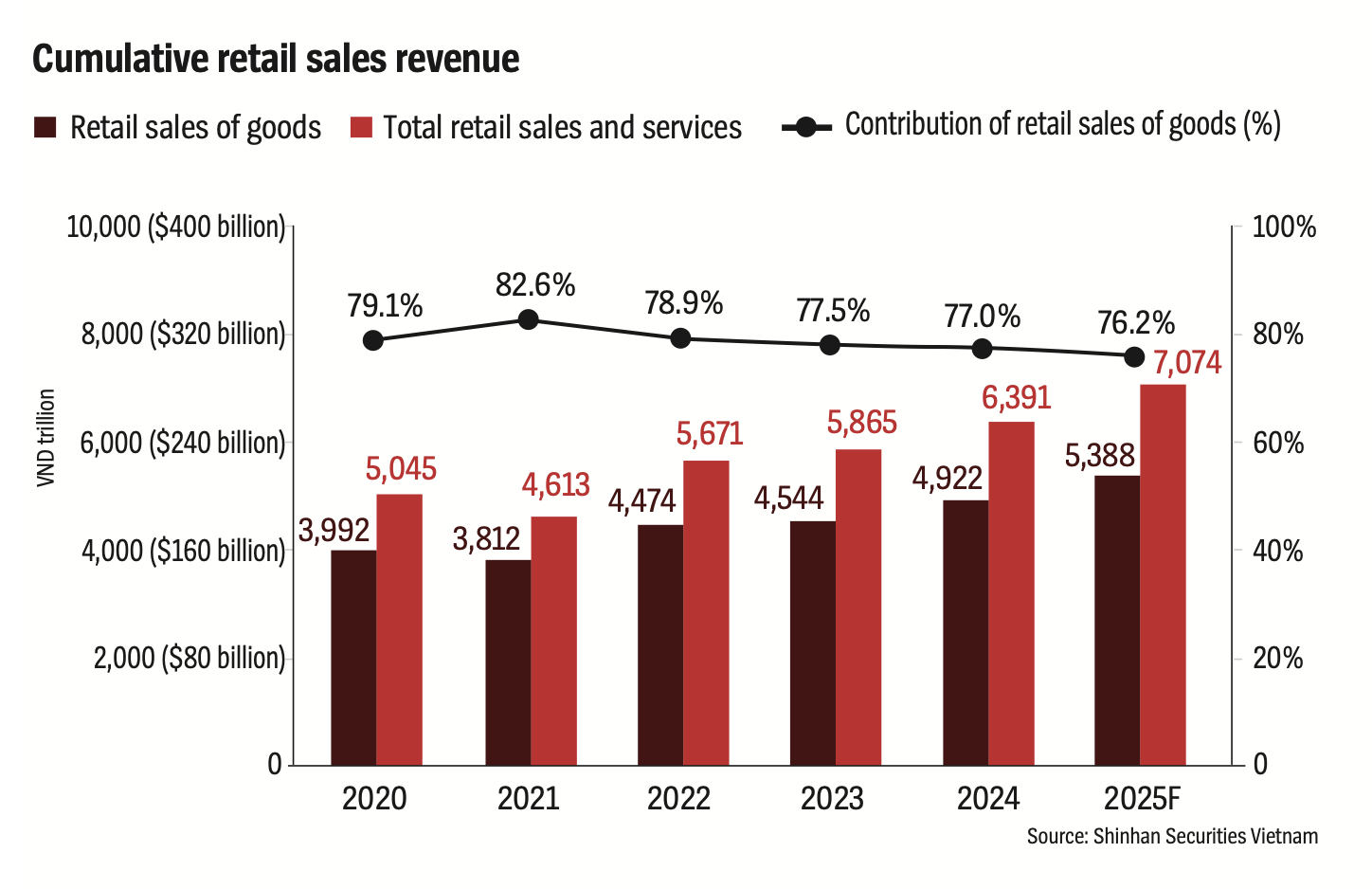
As Vietnam continues to solidify its place as a regional economic powerhouse, its retail industry stands out as one of its most dynamic. The increasing demand from both domestic consumers and international tourists, along with the government’s strategic push for economic development, has contributed significantly to the retail market’s expansion. With a strong foundation and vast untapped potential, the industry is poised for continued progress, especially as it adapts to the evolving landscape of consumer preferences and market demands.
Sound momentum
Increased consumer and travel activity during the five-day break from April 30 to May 4 to mark Reunification Day (April 30) and International Workers’ Day (May 1), along with a continued rise in international tourist arrivals, contributed positively to the growth recorded on Vietnam’s retail and services markets in early 2025. According to the National Statistics Office under the Ministry of Finance, total retail sales of goods and consumer service revenue in April were estimated at VND582.1 trillion ($22.92 billion), up 11.1 per cent compared to the same period in 2024. In the first four months of 2025, total retail sales of goods and consumer service revenue reached an estimated VND2,285.5 trillion ($90.04 billion), reflecting a year-on-year increase of 9.9 per cent and underscoring steady consumer demand along with a strong domestic market base.
According to a report from Shinhan Securities Vietnam, Vietnam’s total retail and service sales are projected to reach VND7,074 trillion ($278.6 billion) this year, with retail sales of goods estimated at VND5,388 trillion ($212.2 billion). Such figures highlight the robust growth trajectory in Vietnam’s domestic consumption market, driven by a young, tech-savvy population and rising disposable incomes. This strong performance also underscores the pivotal role of retail, particularly goods retail, in sustaining Vietnam’s economic momentum amid global uncertainties.
Online retail is playing an increasingly vital role within Vietnam’s broader retail landscape. As consumer habits shift towards greater convenience and digital engagement, e-commerce has become a key growth engine, especially among younger demographics and urban populations. The integration of online platforms with logistics, digital payment systems, and personalized marketing is transforming how products are discovered, purchased, and delivered. This trend not only accelerates the pace of retail innovation but also enhances accessibility for businesses of all sizes, including small and medium-sized enterprises (SMEs) seeking to expand their reach beyond traditional channels.
At a recent conference entitled “Boosting Domestic Market Development and Stimulating Consumption”, organized by the Domestic Market Development and Management Department at the Ministry of Industry and Trade (MoIT), Mr. Tran Huu Linh, Director General of the Department, emphasized that amid ongoing global and regional economic volatility, which continues to disrupt supply chains, impact input prices, influence consumer sentiment, and challenge business operations, the domestic market plays a critically-important role. It serves not only as a pillar of stable growth but also as a “lifeline” for local businesses, particularly when export markets face headwinds.
However, Mr. Linh also pointed out that domestic incomes and consumption are being negatively affected by a slowing global economy, compounded by factors such as trade tensions and exchange rate fluctuations. In response, businesses must swiftly adapt to the growing shift towards online shopping, as well as rising demand for environmentally-friendly products with clear traceability, both of which are becoming key drivers in the retail industry’s transformation.
In an environment marked by global uncertainty and fluctuating external demand, the rise of digital retail platforms is helping businesses tap into resilient local demand, expand market reach, and respond flexibly to shifting preferences. This shift also aligns with Vietnam’s broader goals of digitalization and sustainable growth, positioning the country to harness long-term opportunities in the increasingly competitive regional retail landscape.

E-commerce boom
The rapid advancement of digital technology has driven businesses in Vietnam to increasingly expand and invest in online retail, particularly via e-commerce channels. According to the Q1 2025 Online Retail Market Report and Q2 Forecast, released recently by data analytics platform Metric, Vietnam’s e-commerce industry maintained robust growth in both revenue and transaction volume during the opening three months of 2025. Total sales across the entire e-commerce market reached some VND101.4 trillion ($4 billion), marking a 42.29 per cent increase compared to the same period of 2024. Meanwhile, the volume of goods sold hit 950.7 million units, up 24 per cent year-on-year.
Similarly, the Vietnam E-commerce Index (EBI) 2025 report, released on April 25 by the Vietnam E-Commerce Association (VECOM), estimated that the country’s e-commerce market stood at $32 billion in 2024, growing at a robust 27 per cent. Of this, online retail sales accounted for $22.5 billion, a 30 per cent increase against 2023. E-commerce revenue last year represented roughly 12 per cent of the total retail sales of goods and consumer services, up 10 per cent year-on-year. Online retail sales alone accounted for 11 per cent of total retail goods revenue, surpassing the 8.8 per cent recorded in 2023. These figures underscore the growing role of digital channels in shaping Vietnam’s consumer economy.
Despite such impressive growth, Vietnam’s online retail industry still accounts for a relatively modest share of total retail and consumer service revenue compared to global standards. Several underlying factors have driven its rapid expansion, including a low initial base, strong GDP growth, and a youthful, tech-savvy population. Crucially, many investors, particularly foreign investors, have prioritized gaining market share over profitability during this phase, fueling aggressive pricing, promotions, and digital innovation that continue to stimulate online shopping demand.
In addition, the relatively lenient tax oversight of online business activities in recent years has allowed many e-retailers to operate without formal tax obligations. This has, in effect, created a de facto tax incentive, further accelerating the development of Vietnam’s digital retail landscape. However, this environment is poised for significant change starting in 2025, as regulatory enforcement strengthens and investor expectations evolve. These shifts are likely to reshape the growth dynamics of the online retail industry, pushing it towards greater transparency, efficiency, and long-term sustainability.
Regarding the scale of the online retail market on e-commerce platforms in 2024, along with a series of policies and legal documents set to take effect or be issued in 2025, the VECOM report assessed this year as a preparatory phase for a new stage of development, characterized by rapid and sustainable development.
As Vietnam continues to embrace the growth of e-commerce, particularly in the online retail industry, the next few years are poised to shape the future of the industry. With robust growth in online sales and government-backed policies fostering innovation and digitalization, the stage is set for a new era of rapid and sustainable development in Vietnam’s retail landscape.








 Google translate
Google translate